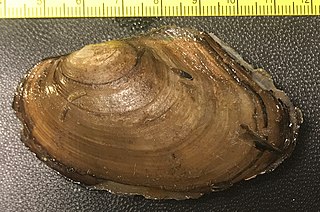
The northern riffleshell is a subspecies of freshwater mussel, an aquatic bivalve mollusk in the family Unionidae, the river mussels. This mussel is endangered and federally protected. It was proposed as a species, Epioblasma rangiana, by Williams et al. (2017).

Ellipsaria lineolata is a species of freshwater mussel, an aquatic bivalve mollusk in the family Unionidae, the river mussels. This is the sole species in the monotypic genus Ellipsaria . This species is native to the drainage systems of the Mississippi River, the Mobile River, the Tennessee River, and the Cumberland River in the United States. It exists in the midwestern United States, and has also been observed in the east coast and as far south as the Gulf of Mexico. The common name of Ellipsaria lineolata is the Butterfly Mussel.

Epioblasma arcaeformis, the sugarspoon or arc-form pearly mussel, was a species of freshwater mussel, an aquatic bivalve mollusk in the family Unionidae, the river mussels. No live individuals have been observed since the early 20th century. The IUCN declared the arc-form pearly mussel to be extinct, publishing its new status on the 2000 Red List following an assessment in the same year.

Epioblasma is a North American genus of freshwater mussels, aquatic bivalve mollusks in the family Unionidae, the river mussels. Most of the species in this genus have been lost in modern times, and the entire genus is threatened with the possibility of extinction.

Epioblasma biemarginata, the angled riffleshell, was a species of freshwater mussel, an aquatic bivalve mollusk in the family Unionidae, the river mussels. It is now extinct.

Epioblasma brevidens, the Cumberlandian combshell, is a species of freshwater mussel, an aquatic bivalve mollusk in the family Unionidae. This species is endemic to the United States, found mainly in the states of Tennessee and Virginia. This mussel resides in medium-sized streams to large rivers. The combshell is an endangered species and protected under the Endangered Species Act of 1973 (ESA). The combshell is threatened by habitat modifications and pollution.

The oyster mussel is a rare species of freshwater mussel in the family Unionidae. This aquatic bivalve mollusk is native to the Cumberland and Tennessee River systems of Kentucky, Tennessee, Alabama, and Virginia in the United States. It has been extirpated from the states of Georgia and North Carolina. It is a federally listed endangered species of the United States.

Epioblasma flexuosa, the arcuate pearly mussel or leafshell, was a species of freshwater mussel, an aquatic bivalve mollusk in the family Unionidae, the river mussels. This species was endemic to the United States, where it was found in the major drainages of the Ohio River, including the Cumberland, Tennessee, and Wabash Rivers. Its natural habitat was flowing water.

Epioblasma haysiana, the acornshell or acorn pearly mussel, was a species of freshwater mussel, an aquatic bivalve mollusk in the family Unionidae. It is now extinct.
The forkshell or Lewis pearly mussel, scientific name Epioblasma lewisii, was a species of freshwater mussel, an aquatic bivalve mollusk in the family Unionidae, the river mussels.
Epioblasma othcaloogensis, the southern acornshell or southern acorn riffle shell, was a species of freshwater mussel in the family Unionidae. It was only known from the Coosa and Cahaba Rivers of the southeastern United States.

Epioblasma stewardsonii, the Cumberland leafshell or Steward's pearly mussel, is an extinct species of freshwater mussel in the family Unionidae.

Epioblasma turgidula, the turgid blossom pearly mussel, turgid riffle shell, turgid-blossom naiad or turgid blossom, was a species of freshwater mussel, a mollusk in the family Unionidae. The US Fish and Wildlife Service declared the species extinct and delisted it from the Endangered Species Act in 2023.

Hamiota altilis, the finelined pocketbook, is a species of freshwater mussel, an aquatic bivalve mollusk in the family Unionidae, the river mussels.
Pleurobema marshalli, the flat pigtoe or Marshall's mussel, was a species of freshwater mussel in the family Unionidae, the river mussels. It was native to Alabama and Mississippi, but it has not been seen since 1980. Though it is still listed as critically endangered on the IUCN Red List and as an endangered species on the US Endangered Species List, it is likely extinct.

The ovate clubshell is a species of freshwater mussel, an aquatic bivalve within the family of Unionidae.
Pleurobema taitianum, the heavy pigtoe or Judge Tait's mussel, is a species of freshwater mussel, an aquatic bivalve mollusk in the family Unionidae, the river mussels.

The winged mapleleaf, also known as false mapleleaf, or hickory nut shell, and with the scientific name Quadrula fragosa, is a species of freshwater mussel. It is an aquatic bivalve mollusk in the family Unionidae, the river mussels. It is endemic to the United States.

Epioblasma obliquata, commonly called the catspaw, is a species of freshwater mussel. It is native to eastern North America, where it is classified as endangered under the Endangered Species Act. There are two subspecies, each with distinct morphology. Due to species rarity, the behavior of this organism is unknown beyond general freshwater mussel behavior.

The winged floater is a species of freshwater mussel, an aquatic bivalve mollusk.















